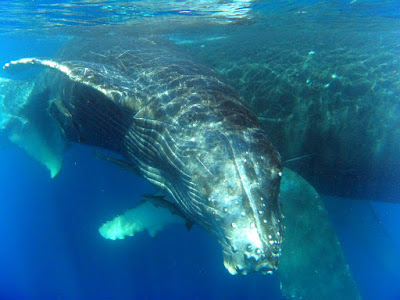En
route to Blue Lagoon Resort
Our three flights on day 9 were all on time or early, and
the last one, a seaplane, brought us to the beautiful Blue Lagoon Resort in
Fiji. Months ago, we had hesitated to
book a place named after that stupid Brooke Shields movie—how cheesy can you
get? But after reading the high praise
from others (and learning the price included all meals and the seaplane ride),
we took the plunge. Now that we are
here, on the island of Nacula, we find that the resort is actually not located
on Blue Lagoon Beach. In fact, Blue
Lagoon Beach is not even on Nacula, but on the island of Nanuya Lailai, just
south of here. We must have seen it from
the air, while the pilot was showing us the resort of Turtle Island ($2,700 per
night per person, so we skipped consideration of that one). Oh, well; that’s about $2,650 above Charlie’s
price range . . .
Disembarking
the seaplane
Wireless
and Internet service here is almost nonexistent, and since we will spend the
next few days eating, sleeping, snorkeling, and being generally worthless, we
are going to thrill you with one final brief report from the South Pacific
before beginning the two-day trek home.
First, a bit about the country.
Resort
from the water
Both the Melanesians and the
Polynesians came here in canoes, beginning around 1200 B.C. No written record exists of their history in
these islands, and regular European contacts began in the late 18th
Century. Captain Cook named the place, apparently misunderstanding what the
natives called it, and Captain William Bligh passed through in his open boat in
1789 after the mutiny over in Tonga. By
1850 the missionaries had begun convincing the natives to put some clothes on,
and today they are very conservative, even prohibiting that disgusting European
practice of going topless on the beaches.
Thank goodness for the missionaries!
Beach
in front of the resort
This was
also one of the two thousand places on Earth colonized by the British, who
imported thousands of Indian laborers to work the sugar plantations before granting
the place
independence in 1970. By now the Indo-Fijian
people made up more than 40% of the population, and before you knew it, they
had a majority in the Fijian parliament.
This ticked off many of the “locals”, and a lieutenant colonel named Rabuka
took over in a bloodless coup, invalidating the constitution, declaring himself
the head of state, and kicking out of office those pesky Indo-Fijians. This was disastrous to the economy and 50,000
or so of the minority members left the country.
Finally, a new constitution was adopted in 1997, and wouldn’t you know
it—the Indo-Fijians won most of the seats in Parliament again, and one of them
was even elected prime minister. In a case of
deja-vu all over again, another coup by the indigenous people in 2000 resulted
in the revocation of the constitution, and politics has been a general mess
here ever since. The latest constitution, adopted in 2013, seems to insure that the minority Indo-Fijians will never be much of a force in the government. Good thing we never had
such political foolishness in the good old USA.
Blue fish on coral
OK, back to the beach, where we are spending
5 nights before a final day on the main island.
But what can you say about a beautiful beach with a huge reef out front
for snorkeling with beautiful fish and fantastic coral formations? There are plenty of activities, including
visits to native villages, mountain climbing, partying, kava ceremonies, and
hammock-tending. That last one is
particularly appealing, and while we engage in that one, a few final photos
from a great trip to the South Pacific.
Sleeping on the beach every day and snorkeling over a fantastic reef between naps has made writing a blog just too much to bear, although we made the effort every day--honest! So after five
more flights over two days, we’ll be back home soon. It has been an exciting and relaxing
trip to the South Pacific, and we hope you have enjoyed coming along with
us. Until next time . . .
Charlie and Tricia
© 2015




























